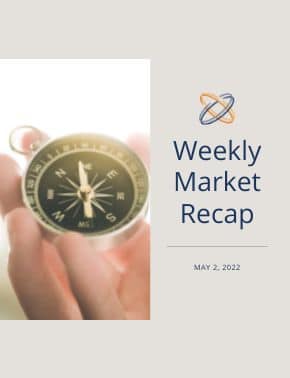Week in Review
Equity Markets:
After a strong rally on Thursday, the S&P took a sharp turn downward to end the week down 3.3%. The S&P is negative 13% year-to-date. The equity market has many headwinds to overcome, including tightening monetary policy, inflation, the conflict in Ukraine, and the more recent slowing economic and earnings growth.
A little over half of the S&P companies have reported, and negative surprises have come from the companies we all have grown accustomed to seeing outperform on a grand scale. The FAANG stocks have shown signs of weakness with many missing on revenue and earnings. Supply chain issues have been a key headwind for the largest companies in the world. Outside of these headline misses, earnings have been in line with the 5-year average according to FactSet, with 80% of companies beating earnings expectations and 72% beating revenue estimates.
Companies have reported earnings growth of 7.1% according to FactSet. If this continues, Q1 earnings will overtake the 4.7% that was expected at the end of March.
Fixed Income Markets:
Bonds also took a hit last week, as the yield on the 10-year treasury jumped to 2.94%. The yield curve has continued its flattening trend. The 2’s/10’s spread stands at ~0.2%. Much of this is likely attributed to the FOMC meeting and the markets expectation for a lift to short-term rates by 0.5%.
Economic:
A major surprise was the economic contraction in Q1. Real GDP (which is adjusted for inflation) declined 1.4% last quarter. At first glance, this can be worrisome. But, upon taking a deeper look at the details, it doesn’t raise as many alarms. Much of the detraction came from reductions in exports and inventory spending. The consumer remains strong, and consumer spending makes up ~70% of the US economy, according to FactSet. As long as consumer strength stays high, it should provide a strong backstop for other areas of the economy that may take short-term hits.
A closely watched inflation indicator, the Personal Consumption Expenditures Price Index rose 6.6% in April, a 40-year high, and reinforces the stance the Fed has recently taken.
Looking Ahead
Equity Markets:
The S&P has returned to the March lows amid the growing headwinds. It is wise to look past the headlines because they will most often not impact long-term expectations. We prefer to look at the health of the market as a whole. Earnings growth is the main driver for stock appreciation over the long run. Growth has slowed, but companies have continued to surprise on the upside in aggregate.
Volatility will likely remain high as the market works through the headwinds. We see this continuing for months to come and investors should be prepared. Having a well-diversified portfolio that matches your risk tolerance will help investors stay invested.
Fixed Income Markets:
The FOMC meets Tuesday and Wednesday, and will likely deliver a 0.50% rate hike. Fixed income traders are starting to price in a more aggressive policy than what has currently been portrayed. The bond market is showing a potential 0.75% rate hike later this year. This is not the base case, and we see the Fed staying on course of what they have indicated, potentially becoming less aggressive. The bond market has done much of the work for the Fed already as the 10-year Treasury yield has increased over 1.3% in 2022 with only one rate hike thus far.
We believe rates still have room to go higher, but will stay in the 2.5-3.25% range over the next year or so. There could be short bouts of rates falling out of this range, but they will likely settle back if this occurs. With volatility likely to continue in the equity markets, the downside protection that treasuries can provide has increased with higher rates.
Economic:
We will see important manufacturing and service sector reports from ISM this week; along with JOLTS and factory orders. The FOMC meeting will garner the most attention as the market anticipates the 50-basis point rate increase.
Important Disclosures:
Investment Advisory Services offered through Krilogy®, an SEC Registered Investment Advisor. Please review all prospectuses and Krilogy’s Form ADV 2A carefully prior to investing. This is neither an offer to sell nor a solicitation of an offer to buy the securities described herein. An offering is made only by a prospectus to individuals who meet minimum suitability requirements.
All expressions of opinion are subject to change. This information is distributed for educational purposes only, and it is not to be construed as an offer, solicitation, recommendation, or endorsement of any particular security, products, or services.
Diversification does not eliminate the risk of market loss. Investments involve risk and unless otherwise stated, are not guaranteed. Investors should understand the risks involved of owning investments, including interest rate risk, credit risk and market risk. Investment risks include loss of principal and fluctuating value. There is no guarantee an investing strategy will be successful. Past performance is not a guarantee of future results. Indices are not available for direct investment; therefore, their performance does not reflect the expenses associated with the management of an actual portfolio. The S&P data is provided by Standard & Poor’s Index Services Group.
Services and products offered through Krilogy® are not insured and may lose value. Be sure to first consult with a qualified financial advisor and/or tax professional before implementing any strategy discussed herein.














